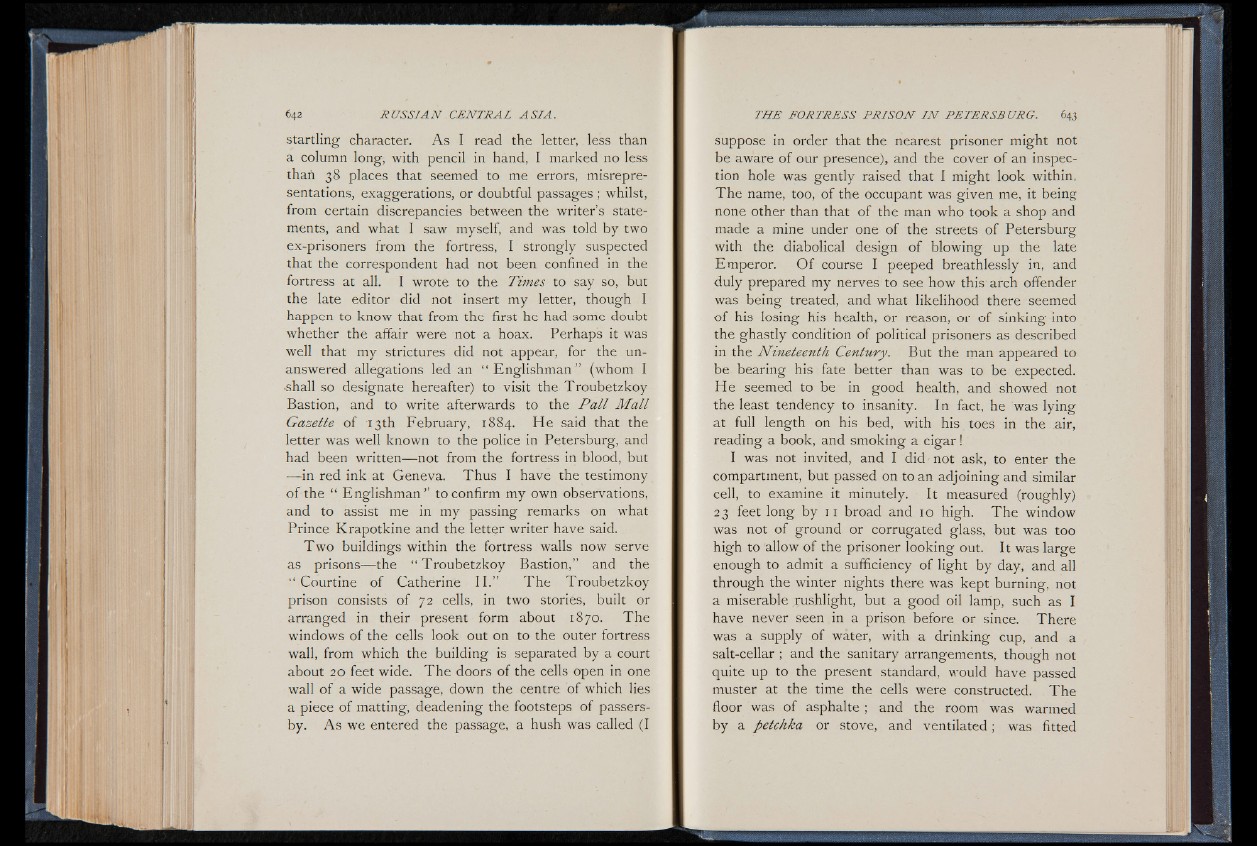
startling character. As I read the letter, less than
a column long; with pencil in hand, I marked no less
than 38 places that seemed to me errors, misrepresentations,
exaggerations, or doubtful passages ; whilst,
from certain discrepancies between the writer’s statements,
and what I saw myself, and was told by two
ex-prisoners from the fortress, I strongly suspected
that the correspondent had not been confined in the
fortress at all. I wrote to the Times to say so, but
the late editor did not insert my letter, though I
happen to know that from the first he had some doubt
whether the affair were not a hoax. Perhaps it was
well that my strictures did not appear, for the unanswered
allegations led an “ Englishman” (whom I
■shall so designate hereafter) to visit the- Troubetzkoy
Bastion, and to write afterwards to the P a ll M a ll
Gazette of 13th February, 1884. He said that the
letter was well known to the police in Petersburg, and
had been written— not from the fortress in blood, but
— in red ink at Geneva. Thus I have the testimony
of the “ Englishman” to confirm my own observations,
and to assist me in my passing remarks on what
Prince Krapotkine and the letter writer have said.
Two buildings within the fortress walls now serve
as prisons— the “ Troubetzkoy Bastion,” and the
“ Courtine of Catherine I I .” The Troubetzkoy
prison consists of 72 cells, in two stories, built or
arranged in their present form about 1870. The
windows of the cells look out on to the outer fortress
wall, from which the building is separated by a court
about 20 feet wide. The doors of the cells open in one
wall of a wide passage, down the centre of which lies
a piece of matting, deadening the footsteps of passers-
by. As we entered the passage, a hush was called (I
suppose in order that the nearest prisoner might not
be aware of our presence), and the cover of an inspection
hole was gently raised that I might look within.
The name, too, of the occupant was given me, it being
none other than that of the man who took a shop and
made a mine under one of the streets of Petersburg
with the diabolical design of blowing up the late
Emperor. O f course I peeped breathlessly in, and
duly prepared my nerves to see how this arch offender
was being treated, and what likelihood there seemed
of his losing his health, or reason, or of sinking into
the ghastly condition of political prisoners as described
in the Nineteenth Century. But the man appeared to
be bearing his fate better than was to be expected.
He seemed to be in good health, and showed not
the least tendency to insanity. In fact, he was lying
at full length on his bed, with his toes in the .air,
reading a book, and smoking a c ig a r !
I was not invited, and I did not ask, to enter the
compartment, but passed on to an adjoining and similar
cell, to examine it minutely. It measured (roughly)
23 feet long by 11 broad and 10 high. The window
was not of ground or corrugated glass, but was too
high to allow of the prisoner looking out. It was large
enough to admit a sufficiency of light by day, and all
through the winter nights there was kept burning, not
a miserable rushlight, but a good oil lamp, such as I
have never seen in a prison before or since. There
was a supply of water, with a drinking cup, and a
salt-cellar ; and the sanitary arrangements, though not
quite up to the present standard, would have passed
muster at the time the cells were constructed. The
floor was of asphalte ; and the room was warmed
by a petchka or stove, and ventilated; was fitted